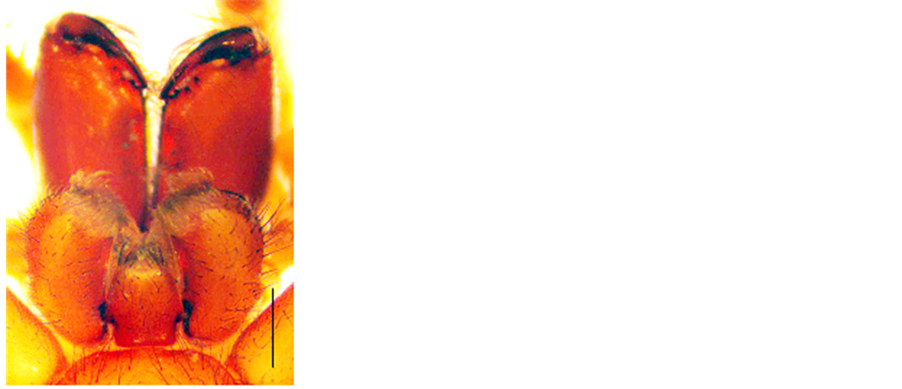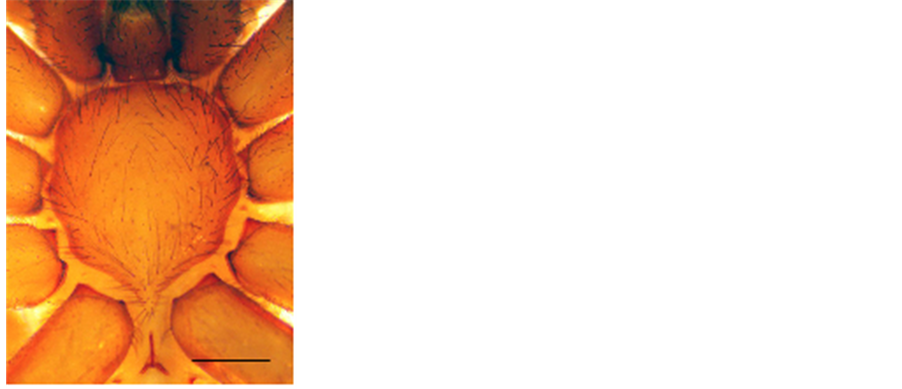Open Journal of Animal Sciences
Vol.04 No.03(2014), Article ID:47318,4 pages
10.4236/ojas.2014.43017
A New Species of the Genus Alloclubionoides Paik, 1992 (Araneae: Agelenidae) from Korea
Joo-Pil Kim*, Seong-Hun Ye
The Arachnological Institute of Korea, Kyunggi-Do, Korea
Email: *jpkim@dongguk.edu
Copyright © 2014 by authors and Scientific Research Publishing Inc.
This work is licensed under the Creative Commons Attribution International License (CC BY).
http://creativecommons.org/licenses/by/4.0/



Received 20 April 2014; revised 31 May 2014; accepted 16 June 2014
ABSTRACT
In the present paper, the authors describe one new species of the family Agelenidae from Korea, named Alloclubionoides persona sp. nov. This specimen is deposited at the Joo-Pil Spider Museum, Namyangju-Si, Kyunggi-Do.
Keywords:
Araneae, Agelenidae, Alloclubionoides, New Species, Korea, Alloclubionoides persona

1. Introduction
All around the world, there were 1157 recorded species belonging to the genera [1] . The identity of Alloclubionoides paikwunensis (Kim and Jung, 1993) is clarified by examination of type specimen and the female of the species is redescribed with additional collections and illustrated. Alloclubionoides soleasp. nov. from the Dadohaehaesang Marine National Park, southern Korea is described with detailed illustrations, leg spination, trichobothrium patterns and scanning electron micrographs [2] . During the spider fauna, PyeongchangGun, one new species Alloclubionoides persona is found new to science. A detailed description of this new species is given in the present paper. All the measurements are given in mm.
In the present paper, the author would like to describe a new species of the Genus Alloclubionoides: Alloclubionoides personan. sp. The type of new species is deposited in the collection of Joo-Pil Spider Musum, Namyangju-Si, Kyunggi-Do.
Seventeen species of the Genus Alloclubionoides have been reported from Korea [3] - [5] .
Family: Agelenidae C. L. Koch, 1837.
Genus: Alloclubionoides Paik, 1992.
1. Alloclubionoides bifidus (Paik, 1976).
2. Alloclubionoides cochlea (Kim, Lee & Kwon, 2007) [6] . Ambanus cochlea Kim, Lee & Kwon, 2007, p. 329, Figures 1-24.
3. Alloclubionoides coreanus Paik, 1992. A. coreanus Paik, 1992: Kim & Lee, 2006, p. 1433, Figures 4(A)-(J), Figure 5(A) and Figure 5 (B), Figures 6(A)-(J), Figure 7(B), Figures 8(C)-(F), Figure 9(C) and Figure 9(D) [7] .
4. Alloclubionoides dimidiatus (Paik, 1974). A. dimidiatus (Paik, 1974): Kim & Lee, 2008, p. 66.
5. Alloclubionoides euini (Paik, 1976). A. euini (Paik, 1976): Kim, 2007, p. 704, Figures 1(A)-(J), Figures 2(A)-(H), Figure 3(A) and Figure 3(B), Figures 7(A)-(C).
6. Alloclubionoides jaegeri (Kim, 2007). AmbanusjaegeriKim, 2007, p. 711, Figures 4(A)-(J), Figures 5(A)-(H), Figure 6(A) and Figure 6(B), Figures 7(D)-(F).
7. Alloclubionoides jirisanensis Kim, 2009. A. jirisanensis Kim, 2009, p. 2931, Figures 3(A)-(I), Figure 4(C) and Figure 4(D) (description of male) [8] .
8. Alloclubionoides kayasanensis (Paik 1972) [=Ambanus kayasanensis (Paik 1972) = Coelotes kayasanensis] Agelenidae C. L. Koch, 1837.
9. Alloclubionoides kimi (Paik, 1974). A. kimi (Paik, 1974): Kim & Lee, 2008a, p. 66. Figures 1-9 (description of female) [9] .
10. Alloclubionoides lunatus (Paik, 1976). A. lunatus (Paik, 1976): Kim & Lee, 2006, p. 142, Figures 1(A)-(J), Figure 2(A) and Figure 2(B), Figures 3(A)-(J), Figure 7(A), Figure 8(A) and Figure 8(B), Figure 9(A), Figure 9(B), Figure 9(E) and Figure 9(F) (description of male).
11. Alloclubionoides ovatus (Paik, 1974). A. ovatus (Paik, 1976): Kim & Lee, 2008, p. 143, Figures 1(A)-(I) (description of male) [10] .
12. Alloclubionoides paikwunensis (Kim & Jung, 1993).
13. Alloclubionoides quadrativulvus (Paik, 1974).
14. Alloclubionoides terdecimus (Paik, 1978).
15. Alloclubionoides wolchulsanensis (Kim, 2009). A. wolchulsanensis Kim, 2009, p. 2926, Figures 1(A)-(I), Figures 2(A)-(H), Figure 4(A) and Figure 4(B) [8] .
16. Alloclubionoides boryeungensis (Kim & Ye, 2013) (Kim & Kim, 2012) [11] [12] .
17. Alloclubionoides woljeongensis (Kim & Ye, 2014) (Song, 1999) [13] [14] .
2. Description
Alloclubionoides persona sp. nov. (Figure 1 and Figure 2).
Abbreviations used: AER = anterior eye row; AL = abdomen length; ALE = anterior lateral eye; AME = anterior median eye; AME-AME = interval between AMEs; AME-ALE = interval between AME and ALE; AW = abdomen width; CL = carapace length; CW = carapace width; CHL = chelicera length; CHW = chelicera width; El = endite length; EW = endite width; LL = labium length; LW = labium width; LF = leg fomula; LFI = leg fomula index; MOQ = median ocular quadrangle; MOQL = MOQ length; MOQAW = MOQ anterior width; MOQPW = MOQ posterior width; SL = sternum length; SW = sternum width; PER = posterior eye row; PLE = posterior lateral eye; PME = posterior median eye; PME-PME = interval between PMEs; PME-PLE = interval between PME and PLE, TL = total length.
Material examined: Holotype ♀, Dongsan-Ri, Jinbu-Myeon, Pyeongchang-Gun, Kangwon-Do (37˚43'59.06''N, 128˚35'43.32''E) Jun 6th, 2013, leg. Seong-Hun, Ye.
Measurement (mm)
Female (Holotype) TL: 8.47, CL: 4.60, CW: 2.42, AL: 3.87, AW: 2.34, AME: 0.03, ALE: 0.04, AME-AME: 0.15, AME-ALE: 0.17, PME: 0.08, PLE: 0.07, PME-PME: 0.24, PME-PLE: 0.30, MOQL: 0.22, MOQAW: 0.15, MOQPW: 0.24, AER: 0.64, PER: 0.85, EL: 1.00, EW: 0.58, LL: 0.69, LW: 0.52, SL: 1.84, SW: 1.58, CHL: 1.75, CHW: 0.79. Leg I: 9.94, Leg II: 9.10, Leg III: 8.54, Leg IV: 11.48, LF: 4:1:2:3, LFI: 100:92:86:116.
Female: Body length is 8.47 mm with Carapace in light brown, longer than the width. The carapace index is 53, with arched head shape in the sagittal plane. The carapace has median grooves with radial brownish furrow. Cephalic area of carapace raised globular dome. Sternum is uniformly brownish yellow. All eyes are black and yellow, with MOQ longer than width, and MOQAW shorter than MOQPW. Interval of PER is wider than AER.



Figure 1. Alloclubionoides persona sp. nov., holotype female from Mt Odaesan, Korea. (a) habitusdorsal view; (b) carapace; (c) abdomen, dorsal view; (d) habitus; (e) sternum; (f) endites, labium, chelicerae; (g) eye area; (h) abdomen, ventral view; (i) epigynum, ventral view. Scales for (a) and (d) = 5.0 mm; (b), (c) and (h) = 1.0mm; (d) = 3.0 mm; (e)-(g) and (i) = 0.5 mm.
Interval of AME-AME and AME-ALE are nearly the same. Interval of PME-PLE and PME-PME are also nearly the same. AER is recurved and PER is procurved a little bit. Eye sizes are: AME < ALE < PLE < PME (3:4:7:8). Chelicerae are dark brown, robust and quite strongly extended. Endite is longer than width. Labium is longer than width a litter bit. Sternum is hearted-shaped, and the end of sternum is acute. Legs are yellowish brown with leg formula, 4, 1, 2, 3. Abdomen is elongated ovoid, sparsely and uniformly clothed with bright gray and short hairs in dorsum; the venter uniformly clothed with gray and short hairs also.
Diagnosis: This new species is small and bright brown color especially. Present new species is clearly distinguished from all previously described species by the structure of epigyne [15] [16] .
Inhabitation: This species lives at Mt. odaesan in Kangwon-Do of Korea.






Figure 2. Alloclubionoidespersona sp. nov., holotype female from Mt Odaesan, Korea. (a) Genitalia, ventral view; (b) genitalia, dorsal view; (c) habitus,dorsal view; (d) epigynum, ventral view; (e) genitalia, ventral view; (f) genitalia, dorsal view; (g)-(j) setaeon femur, I - IV; (k)-(n) setae ontibia, I - IV; (o)-(r) setaeon metatarsus, I - IV; (s)-(v) setaeon tarsus, I - IV. I - II: Dorsal view. III - IV: Ventral view. Scales for (a), (b), (d) and (f) = 0.5 mm; (c) = 5.0 mm; (g)-(v) = 1.0 mm.
Etymology: This name persona refers to the epigyne which is likely to the mask of some African.
Distribution: Korea.
References
- Platnick, N.I. (2014) The World Spider Catalog, Version 14.5. American Museum of Natural History. http://research.amnh.org/entomology/spiders/catalog/index.html
- Kim. B.W and Kim, J.P. (2012) Redescription of Alloclubionoides paikwunensis (Kim and Jung, 1993) and a New Spider Species Alloclubionoides solea sp. nov. from Korea (Araneae: Agelenidae). Journal of Natural History, 46, 2387-2400. http://dx.doi.org/10.1080/00222933.2012.707246
- Kim, B.W. and Kim, J.P. (2010) A Check List of Korean Spiders (Revised in 2010). Korean Arachnology, 26, 121- 165.
- Paik, K.Y. and Kim, J.P. (1994) A List of Korea Spiders (Revised in 1993). Korean Arachnology, 10, 107-156.
- Kim. J.P. (1998) A List of Korea Spiders (Revised in 1998). Korean Arachnology. 14, 9-54.
- Kim, B.W., Lee, W. and Kwon, T.S. (2007) A New Species of the Genus Ambanus (Arachnida: Araneae: Amaurobiidae) from Korea. Proceedings of the Biological Society of Washington, 120, 327-336. http://dx.doi.org/10.2988/0006-324X(2007)120[327:ANSOTG]2.0.CO;2
- Kim, B.W. and Lee, W. (2006) The Poorly Known Species of the Spider Genus Ambanus (Arachnida: Araneae: Amaurobiidae) in Korea. Journal of Natural History, 40, 1425-1442. http://dx.doi.org/10.1080/00222930600916050
- Kim, B.W. (2009) Two New Species of the Genus Alloclubionoides (Araneae: Amaurobiidae) in Korea. Journal of Natural History, 43, 2925-2935. http://dx.doi.org/10.1080/00222930903244036
- Kim, B.W. and Lee, W. (2008) The True Female of Alloclubionoides kimi (Araneae: Amaurobiidae) from Korea. Zootaxa, 1788, 66-68.
- Kim, B.W. and Lee, W. (2008) Description of the Male of Alloclubionoides ovatus (Arachnida: Araneae: Amaurobiidae) from Korea. Korean Journal of Systematic Zoology, 24, 143-145.
- Kim, J.P. and Ye, S.H. (2013) A New Species of the Genus Alloclubionoides Paik, 1992 (Araneae: Agelenidae) from Korea. Korean Arachnology, 29, 1-16.
- Kim, J.P. and Kim, N.Y. (2012) A New Species of the Genus Thanatus C.L. Koch, 1837 (Araneae: Thomisidae) from Korea. Korean Arachnology, 28, 71-76.
- Kim, J.P. and Ye, S.H. (2014) A New Species of the Genus Callobius Paik, 1966 (Araneae: Amaurobiidae) from Korea. Korean Arachnology, 29, 163-173.
- Song, D.X., Zhu, M.S. and Chen, J. (1999) The Spiders of China. Hebei Science and Technology Publishing House, Shijiazhuang, 353-395.
- Namkung, J. (2002) The Spiders of Korea. Kyo-Hak Publishing Co., Seoul, 5-648.
- Kim, J.P. (2002) Colored Spider of Korea. Academy Publishing Co., Seoul, 292-298.
NOTES
*Corresponding author.
























